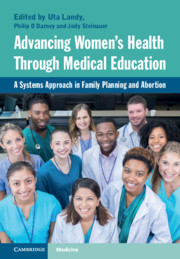 Advancing Women's Health Through Medical Education
Advancing Women's Health Through Medical Education from Section IV - Reproductive Health Services & Abortion Training: Global Examples
Published online by Cambridge University Press: 30 July 2021
We describe a collaborative training program aimed at improving access to and quality of integral abortion care, with a focus on the legally induced termination of pregnancy (ToP) program (ILE in Spanish) in Mexico City, after its decriminalization in 2007.Where legal framework is altogether or severely restricted, formal teaching and training for medical and nurse students is extremely poor, and access to recommended surgical and medical technologies is limited. On the contrary, where the law favors ample access to the procedure, updated, evidence-based guidelines and protocols usually ensue. In Mexico City, training health professionals immediately followed, and even preceded, legal changes, with in-service person-to-person trainings up to a mentoring and a Training of Trainers (ToT) modality, which presently assure that 100% of ILEs are done with recommended technologies. Training in abortion and related care, should ideally be integrated in pre-service curricula, to assure its sustainability and eliminate related stigma.
To save this book to your Kindle, first ensure no-reply@cambridge.org is added to your Approved Personal Document E-mail List under your Personal Document Settings on the Manage Your Content and Devices page of your Amazon account. Then enter the ‘name’ part of your Kindle email address below. Find out more about saving to your Kindle.
Note you can select to save to either the @free.kindle.com or @kindle.com variations. ‘@free.kindle.com’ emails are free but can only be saved to your device when it is connected to wi-fi. ‘@kindle.com’ emails can be delivered even when you are not connected to wi-fi, but note that service fees apply.
Find out more about the Kindle Personal Document Service.
To save content items to your account, please confirm that you agree to abide by our usage policies. If this is the first time you use this feature, you will be asked to authorise Cambridge Core to connect with your account. Find out more about saving content to Dropbox.
To save content items to your account, please confirm that you agree to abide by our usage policies. If this is the first time you use this feature, you will be asked to authorise Cambridge Core to connect with your account. Find out more about saving content to Google Drive.